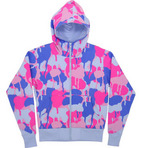Color Me Urban
/Two limited-edition hoodies from Kidrobot. Sold out, of course. Left: Spraypaint camouflage by Nico Berry. Right: A twisted version of the Louis Vuitton logo pattern by Tilt.
Today the New York Times ran an article by Ruth La Ferla on the global trend of urban streetwear. This topic is something that I've been thinking about a lot lately, not in the least because I actually WEAR some of what is considered urban clothing. The signifiers of streetwear - bright colors, camouflage, hoodies, puffy sneakers, baggy jeans, tracksuits, jewelry - have direct roots in the 1980s and early 1990s. And, significantly, one only has to think of Stephen Sprouse's reinterpretation of Andy Warhol's acid-color prints to realize that the art scene back then was a significant contributor to underground fashion.
This relationship between urban fashion and art is especially evident today, especially in the utilization of clothing as a blank canvas on which artists (many of them practicing street art) can create designs. In fact, this renewal in urban fashion is really just a part of a larger urban culture movement which includes vinyl toys, accessories, jewelry, music, books and graffiti. While there is still an anti-fashion element to today's urban culture, it has become such a lucrative field (think of A Bathing Ape's success) that important fashion players like Fendi, Louis Vuitton and Visionaire are angling for a slice of the action alongside companies like Stussy, Triple 5 Soul, Maharishi, and Ice Cream (Pharrell William's label). While one might wonder about mainstream fashion's credibility in the urban scene, it is a surprisingly symbiotic affair with limited-edition collaborations and cheeky reinterpretations of logos.
An excellent example of this interplay between fashion and anti-fashion is evident in Kidrobot's story. Kidrobot is actually a newcomer to the urban fashion scene, only recently launching an amazingly successful apparel line. Kidrobot's main expertise is in the creation of limited-edition toys decorated by the hippest underground artists. Word has it that the curator of a large art museum in Manhattan is an avid collector of toys from Kidrobot, and they were recently included in the Cooper-Hewitt National Design Museum's Triennial as part of the best design around today. I spoke to my good friend and the manager of the Kidrobot store in Soho, James May, about Kidrobot's success. Read what he has to say about this exploding movement after the jump.
Why did Kidrobot start producing a clothing line?
It was a natural progression. It started first with asking artists to decorate sneakers and then logically moved to apparel. We've actually always done t-shirts. Whether its toys, a sweatshirt or sneakers, they are all blank canvases for artists. Like other companies, many of our clothing designers are actually street artists. Our in-house designer is Maze.
What fashion designers has Kidrobot collaborated with?
Karl Lagerfeld, Marc Jacobs, Jil Sander, Heatherette, Dries Van Noten, Duckie Brown, Nike... The Visionaire collaboration included Karl Lagerfeld, Helmut Lang, Versace, Prada, Comme des Garçons, Viktor and Rolf, Hedi Slimane and Alexander McQueen.
Did Kidrobot approach them, or the other way around?
Both. The collaborations started about two years ago, with the end result being limited edition toys (numbering anywhere from 100 to 500) wearing designer clothing. We are being approached now by musicians, stylists and other fashion designers.
How has Kidrobot's apparel line been received?
Since almost all products are produced in limited quantities (many have a run of 228), they all almost immediately sell out.
Who is the average Kidrobot customer?
There is no such thing. Our customers are of any age, color, male and female. Anyone can wear Kidrobot clothes or collect our toys.
Do you agree that the reason streetwear is so colorful is due to the influence of graffiti and street art?
Definitely.
Kidrobot can be found online at kidrobot.com or visit one of their retail stores in NYC, San Francisco or Los Angeles.
Sarah Scaturro







